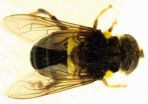(Press-News.org) A new way of measuring the mass of supermassive black holes could revolutionise our understanding of how they form and help to shape galaxies.
The technique, developed by a team including Oxford University scientists, can spot the telltale tracer of carbon monoxide within the cloud of gas (mostly hydrogen) circling a supermassive black hole at the centre of a distant galaxy. By detecting the velocity of the spinning gas they are able to 'weigh' (determine the mass) of the black hole.
Detailed information on supermassive black holes, thought to be at the heart of most galaxies, is scarce: it has taken 15 years to measure the mass of just 60. The problem is that most other supermassive black holes are too far away to examine properly even with the Hubble Space Telescope.
The new method, when combined with new telescopes such as ALMA (Attacama Large Millimetre/submillimetre Array), promises to extend this black hole 'weigh-in' to thousands of distant galaxies. It will also enable the study of black holes in spiral galaxies (similar to our own Milky Way), which are hard to target using currently available techniques.
A report of the research is published in this week's Nature.
The team demonstrated the new technique on the supermassive black hole at the centre of a galaxy, NGC 4526, in the constellation of Virgo. NGC 4526 was chosen as a test because it has been widely studied but the team believe the technique will work on a wide range of different galaxies.
Tim Davis of the European Southern Observatory, lead author of the paper, said: 'We observed carbon monoxide molecules in the galaxy we were monitoring using the Combined Array for Research in Millimetre-wave Astronomy (CARMA) telescope. With its super-sharp images we were able to zoom right into the centre of the galaxy and observe the gas whizzing around the black hole. This gas moves at a speed which is determined by the black-hole's mass, and the distance from it. By measuring the velocity of the gas at each position, we can measure the mass of the black hole.'
Dr Michele Cappellari of Oxford University's Department of Physics, an author of the paper, said: 'Because of the limitations of existing telescopes and techniques we had run out of galaxies with supermassive black holes to observe. Now with this new technique and telescopes like ALMA we will be able to examine the relationship between thousands of more distant galaxies and their black holes giving us an insight into how galaxies and black holes co-evolve. Importantly our 'weigh-in' technique will work for all kinds of galaxies, including spiral galaxies which are particularly difficult to observe with previous techniques.'
Dr Martin Bureau of Oxford University's Department of Physics, an author of the paper, said: 'The ALMA telescope is now in the final stages of construction and our team is currently bidding for time to use it for our black hole survey. If all goes according to plan we could begin our survey by the end of this year.'
### END
Gas promises bumper black hole 'weigh-in'
2013-01-31
ELSE PRESS RELEASES FROM THIS DATE:
Study finds hormones can change the breast's genetic material
2013-01-31
Melbourne scientists have discovered how female steroid hormones can make dramatic changes to the genetic material in breast cells, changes that could potentially lead to breast cancer.
Researchers from the Walter and Eliza Hall Institute of Medical Research in Melbourne, Australia, have identified how pregnancy hormones send signals to critical molecules on the DNA to make changes in the epigenome. The epigenome is a series of chemical tags that modify DNA, controlling which genes are switched on and off.
Professor Jane Visvader, Dr Bhupinder Pal, Professor Geoff Lindeman ...
Cyclone did not cause 2012 record low for Arctic sea ice
2013-01-31
It came out of Siberia, swirling winds over an area that covered almost the entire Arctic basin in the normally calm late summer. It came to be known as "The Great Arctic Cyclone of August 2012," and for some observers it suggested that the historic sea ice minimum may have been caused by a freak summer storm, rather than warming temperatures.
But new results from the University of Washington show that the August cyclone was not responsible for last year's record low for Arctic sea ice. The study was published online this week in Geophysical Research Letters.
"The ...
Electronic health records could help identify which patients most need ICU resources
2013-01-31
ANN ARBOR, Mich. — A national shortage of critical care physicians and beds means difficult decisions for healthcare professionals: how to determine which of the sickest patients are most in need of access to the intensive care unit.
What if patients' electronic health records could help a physician determine ICU admission by reliably calculating which patient had the highest risk of death?
Emerging health technologies – including reliable methods to rate the severity of a patient's condition – may provide powerful tools to efficiently use scarce and costly health resources, ...
International team observe 'hungry twin' stars gobbling their first meals
2013-01-31
AMHERST, Mass. – Just-forming stars, like growing babies, are always hungry and must "feed" on huge amounts of gas and dust from dense envelopes surrounding them at birth. Now a team of astronomers including Robert Gutermuth, a University of Massachusetts Amherst expert in imaging data from the Spitzer Space Telescope, reports observing an unusual "baby" star that periodically emits infrared light bursts, suggesting it may be twins, that is, a binary star. The discovery is reported this month in Nature.
The extremely young object, dubbed LRLL 54361, is about 100,000 years ...
Novel materials shake ship scum
2013-01-31
DURHAM, N.C. – Just as horses shake off pesky flies by twitching their skin, ships may soon be able to shed the unwanted accumulation of bacteria and other marine growth with the flick of a switch.
Duke University engineers have developed a material that can be applied like paint to the hull of a ship and will literally be able to dislodge bacteria, keeping it from accumulating on the ship's surface. This buildup on ships increases drag and reduces the energy efficiency of the vessel, as well as blocking or clogging undersea sensors.
The material works by physically ...
Biologistics: How fast do chemical trains move in living cells?
2013-01-31
The rate of chemical processes in cells is dictated by the speed of movement (diffusion) of molecules needed for a given reaction. Using a versatile method developed at the Institute of Physical Chemistry of the Polish Academy of Sciences in Warsaw, researchers were able to predict for the first time the diffusion coefficients of all proteins in Escherichia coli. The achievement is important not only for biologists and chemists, but also for... transport companies.
Understanding of chemical foundations of life requires knowledge about the rate of chemical reactions in ...
24 new species of flower fly have been found in Central and Southern America
2013-01-31
A team of scientists have described twenty four new species of dipterans belonging to Quichuana genus, of which only a further 24 species were known. The researchers, including two Spanish biologists, have been studying the forests of Central and Southern America for ten years and they have now published their results in the 'Zoological Journal of the Linnean Society'.
A ten-year study in forests of the American continent has resulted in the description of 24 new insect species from the Quichuana genus that are also known as 'flower flies'.
Up until now only a further ...
Rehabilitation therapies can lead to recovery from chronic fatigue syndrome
2013-01-31
Research led by Queen Mary, University of London, has shown that recovery from chronic fatigue syndrome (CFS) is possible for some patients, and has identified two treatments most likely to lead to recovery.
The latest results from the PACE trial* show that cognitive behaviour therapy (CBT) and graded exercise therapy (GET), as supplements to specialist medical care, increase the likelihood of recovery from CFS three-fold compared to other treatments studied. The trial, carried out in collaboration with researchers from King's College London, the University of Oxford ...
The humble 'virtual chimney' fences that could reduce the impact of airport pollution
2013-01-31
Simple 'blast' fences called baffles could deliver improvements in air quality for people living near airports, new research has found.
Placed behind a runway, the baffles could serve as a 'virtual chimney', funnelling emissions from aircraft engines upwards where they can disperse more effectively, thereby reducing the environmental impact on people living nearby.
Prototype baffles have been tested by a team of researchers from Manchester Metropolitan University, Cranfield University, University of Southampton and the University of Cambridge, with funding from the ...
Disulfiram: New support for an old addiction drug
2013-01-31
Philadelphia, PA, January 31, 2013 – Disulfiram was the first medication approved for the treatment of alcoholism over 50 years ago. It works, at least in part, by preventing the metabolism of an alcohol by-product, acetaldehyde. High levels of acetaldehyde in the body quickly cause unpleasant symptoms, including nausea, vomiting, headache, and accelerated heart rate. Thus, disulfiram provides a very strong incentive to avoid drinking.
Beginning in the late 1990s, a series of studies conducted at Yale University found that disulfiram reduced the consumption of cocaine, ...



